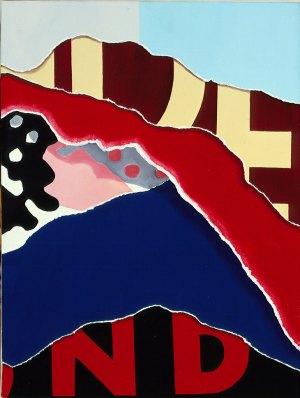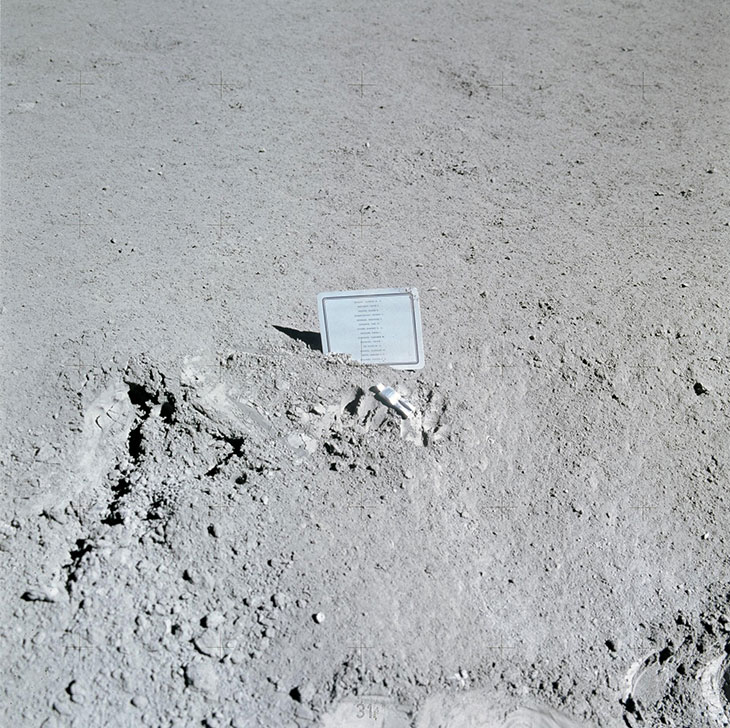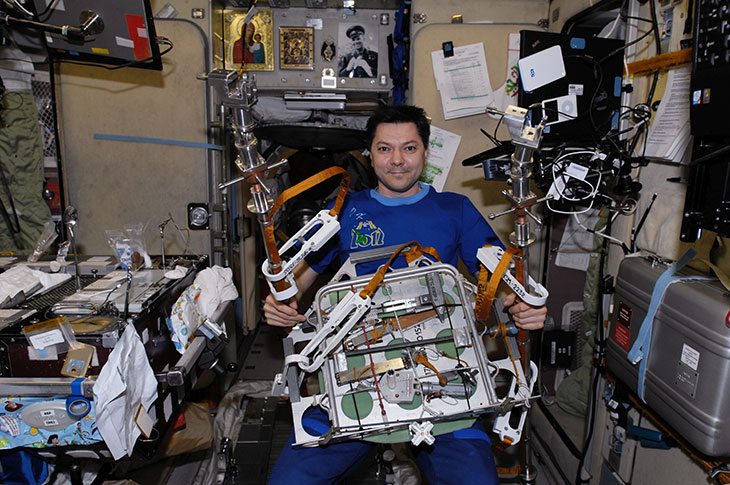Jeff Bezos made headlines on 20 July when he and three companions launched into space on a rocket built by his company Blue Origin. This launch marked the first crewed flight by a Blue Origin vehicle – although Bezos is not the first billionaire to chart a private flight off Earth.
Just five weeks later, another Blue Origin mission took place: as part of an uncrewed launch on 27 August, three works by the Ghanaian artist Amoako Boafo were sent to space and returned. The portraits of the artist, his mother, and his childhood friend Otis Kwame Kye Quaicoe were painted on the panels which covered the parachute compartments on the rocket’s nose. The launch was the first in a series of ‘Suborbital Triptychs’, a collaboration between Blue Origin and a company called Uplift Aerospace. The Miami Beach-based Magnet Art Group is ‘curating’ the Triptych series for Blue Origin and Uplift.
Bezos and Blue Origin are relatively well known. Less is known about Uplift, based in Park City, Utah. On its website, Uplift promotes a new venture called ‘Constellation Vault’: ‘a platform for commercial promotion and exhibition in low Earth orbit’. ‘The Constellation Vault will offer patrons the exclusive opportunity to acquire highly coveted items for private sale and auction in space, delivered upon return to Earth.’
There is a long tradition of sending art to space. Arguably, the first artworks to make the journey were the logos designed and painted by the artist Cece Bibby on three Mercury capsules. (Mercury was the first US human spaceflight programme, which ran from 1958 to 1963.) The Friendship 7 capsule, intact with Bibby’s artwork, is now in the National Air and Space Museum in Washington, D.C. The painted shingles on the Aurora 7 and Sigma 7 capsules, faded and charred through their passage back to Earth, were removed and sent for tests at Purdue University. Assumed lost or destroyed, the shingles resurfaced in 2019 after the death of the scientist who analysed them and were sold at auction for more than $200,000 each.

One of the paintings by Ellery Kurtz flown into space in 1986 as part of NASA’s Get Away Special (GAS) programme. Courtesy the artist; © Ellery Kurtz 1986
In 1986, four paintings by American artist Ellery Kurtz were flown on the Space Shuttle Columbia as a conservation experiment, a collaboration between Kurtz and the environmental psychologist Howard Wishnow. The idea was to see how pigments fared in the increased G-forces of take-off and landing, and in the microgravity conditions of orbit. The paintings, rolled inside a canister, remained in orbit for 98 days. The good news for artists was that there was no evident degradation of the primers or pigments during their brief sojourn in space. In their technical report to NASA, Kurtz and Wishnow wrote: ‘Our research represents a first step in the safe transportation of art into man’s newest frontier, Space.’
Some artworks in space were not meant to return. Fallen Astronaut is an 8.9cm-high schematic human figurine rendered in aluminium by the Belgian artist Paul Van Hoeydonck, which was commissioned and placed on the Moon by the Apollo 15 crew in 1971. Accompanying the statue is a plaque with the names of astronauts and cosmonauts who had died in the service of space. Van Hoeydonck’s efforts to make the statue more accessible on Earth through the sale of replicas initially met with opposition from the Apollo 15 crew, who believed this undermined the memorial purpose of the original. (In 2019 the artist teamed up with a German gallery, Galerie Breckner, to sell limited-edition copies of the work.)

A view of Fallen Astronaut (1971) by Paul Van Hoeydonck, installed on the Moon at the Hadley-Apennine landing site. Photo: courtesy NASA
Most famously, perhaps, the Moon Museum was sent on the Apollo 12 spacecraft in December 1969 – despite not being approved by NASA. The ‘museum’ is a tiny ceramic plaque, 1.9 by 1.3 cm, with engravings by Robert Rauschenberg, David Novos, John Chamberlain, Claes Oldenburg, Forrest Myers and Andy Warhol. Myers, who initiated the project, said in 2011 that ‘sending a man to the Moon in 1969 was the greatest technological feat of my generation. It was one of the rare instances where evolution could be made visible’. He wanted art included in this evolutionary signature.
As numerous missions are planned to return to the Moon in the coming decade, works such as Fallen Astronaut, the Moon Museum, and various other plaques and commemorative objects are likely to become prime targets for looting. There is a global community of collectors interested in space hardware and other space-flown objects, but international law does not provide many protections for heritage.
At the moment, any object gains value by leaving Earth, whether it returns from space or not. Astronauts in the US space programme have taken objects with them on spaceflights specifically for this reason. They are not allowed to sell them for profit, however – a ban which dates back to the scandal of the sale of stamps the Apollo 15 crew took to space. The cosmonaut tradition, meanwhile, is to take religious icons depicting saints or the holy family on to space stations. As recent research which we conducted in collaboration with the icon scholar Wendy Salmond shows, this is sometimes at the request of the Patriarch of the Russian Orthodox church. The returned icons are not sold but distributed to churches.

Russian cosmonaut Oleg Kononenko in the Zvezda Service Module of the International Space Station in 2012. Photo: courtesy NASA
Until recently, any artwork flown into space would have been part of a mission run by a government space agency – even if, as in the case of the Moon Museum, its presence was unauthorised. Now, however, it seems that space-flown art may become one of the commodities on offer in the expanding sphere of private and commercial spaceflight.
A major criticism of the space billionaires and their recent ‘missions’ is that their promise of opening up space for everyone remains unfulfilled: you still need to be wealthy and from the Global North to have access to the experience of spaceflight. Artists in the Afrofuturist tradition have been challenging this colonial dominance since the 1970s. Sun Ra’s film Space is the Place (1972), for example, plays with the idea of an African diaspora in space. The Blue Unity mission selecting an artist from a ‘non-spacefaring’ nation such as Ghana is a nod to calls for a more inclusive space, but falls rather short of real equity.
The lack of clarity surrounding the eventual arrangements for Boafo’s ‘Suborbital Triptych’ is also concerning, particularly given Uplift’s business emphasis on selling items that have been to space. Neither the press release trumpeting the launch of Boafo’s paintings nor any reporting to date has revealed what will happen to the paintings following the flight. Will they be auctioned off, or sold through Boafo’s gallery representatives? Will they be donated to museums? Have they already been promised to or acquired by collectors? How are the proceeds being divided between the artist and the space companies? All that has been stated so far is that Uplift Aerospace will make an unspecified charitable donation to an organisation chosen by the artist.
If the growth in space tourism promoted by companies such as Blue Origin and Virgin Galactic continues, space-flown art may become commonplace rather than a rarity. What this means for both the artists and the works granted passage off-Earth remains to be seen.
Alice Gorman is an associate professor of archaeology at Flinders University and the author of Dr Space Junk vs The Universe (MIT Press). Justin Walsh is associate professor of art history and archaeology at Chapman University.

Outer space – the final frontier for the art market?
Cece Bibby (left) painting the name ‘Friendship 7’ on John Glenn’s Mercury spacecraft in 1962. Photo: courtesy NASA
Share
Jeff Bezos made headlines on 20 July when he and three companions launched into space on a rocket built by his company Blue Origin. This launch marked the first crewed flight by a Blue Origin vehicle – although Bezos is not the first billionaire to chart a private flight off Earth.
Just five weeks later, another Blue Origin mission took place: as part of an uncrewed launch on 27 August, three works by the Ghanaian artist Amoako Boafo were sent to space and returned. The portraits of the artist, his mother, and his childhood friend Otis Kwame Kye Quaicoe were painted on the panels which covered the parachute compartments on the rocket’s nose. The launch was the first in a series of ‘Suborbital Triptychs’, a collaboration between Blue Origin and a company called Uplift Aerospace. The Miami Beach-based Magnet Art Group is ‘curating’ the Triptych series for Blue Origin and Uplift.
Bezos and Blue Origin are relatively well known. Less is known about Uplift, based in Park City, Utah. On its website, Uplift promotes a new venture called ‘Constellation Vault’: ‘a platform for commercial promotion and exhibition in low Earth orbit’. ‘The Constellation Vault will offer patrons the exclusive opportunity to acquire highly coveted items for private sale and auction in space, delivered upon return to Earth.’
There is a long tradition of sending art to space. Arguably, the first artworks to make the journey were the logos designed and painted by the artist Cece Bibby on three Mercury capsules. (Mercury was the first US human spaceflight programme, which ran from 1958 to 1963.) The Friendship 7 capsule, intact with Bibby’s artwork, is now in the National Air and Space Museum in Washington, D.C. The painted shingles on the Aurora 7 and Sigma 7 capsules, faded and charred through their passage back to Earth, were removed and sent for tests at Purdue University. Assumed lost or destroyed, the shingles resurfaced in 2019 after the death of the scientist who analysed them and were sold at auction for more than $200,000 each.
One of the paintings by Ellery Kurtz flown into space in 1986 as part of NASA’s Get Away Special (GAS) programme. Courtesy the artist; © Ellery Kurtz 1986
In 1986, four paintings by American artist Ellery Kurtz were flown on the Space Shuttle Columbia as a conservation experiment, a collaboration between Kurtz and the environmental psychologist Howard Wishnow. The idea was to see how pigments fared in the increased G-forces of take-off and landing, and in the microgravity conditions of orbit. The paintings, rolled inside a canister, remained in orbit for 98 days. The good news for artists was that there was no evident degradation of the primers or pigments during their brief sojourn in space. In their technical report to NASA, Kurtz and Wishnow wrote: ‘Our research represents a first step in the safe transportation of art into man’s newest frontier, Space.’
Some artworks in space were not meant to return. Fallen Astronaut is an 8.9cm-high schematic human figurine rendered in aluminium by the Belgian artist Paul Van Hoeydonck, which was commissioned and placed on the Moon by the Apollo 15 crew in 1971. Accompanying the statue is a plaque with the names of astronauts and cosmonauts who had died in the service of space. Van Hoeydonck’s efforts to make the statue more accessible on Earth through the sale of replicas initially met with opposition from the Apollo 15 crew, who believed this undermined the memorial purpose of the original. (In 2019 the artist teamed up with a German gallery, Galerie Breckner, to sell limited-edition copies of the work.)
A view of Fallen Astronaut (1971) by Paul Van Hoeydonck, installed on the Moon at the Hadley-Apennine landing site. Photo: courtesy NASA
Most famously, perhaps, the Moon Museum was sent on the Apollo 12 spacecraft in December 1969 – despite not being approved by NASA. The ‘museum’ is a tiny ceramic plaque, 1.9 by 1.3 cm, with engravings by Robert Rauschenberg, David Novos, John Chamberlain, Claes Oldenburg, Forrest Myers and Andy Warhol. Myers, who initiated the project, said in 2011 that ‘sending a man to the Moon in 1969 was the greatest technological feat of my generation. It was one of the rare instances where evolution could be made visible’. He wanted art included in this evolutionary signature.
As numerous missions are planned to return to the Moon in the coming decade, works such as Fallen Astronaut, the Moon Museum, and various other plaques and commemorative objects are likely to become prime targets for looting. There is a global community of collectors interested in space hardware and other space-flown objects, but international law does not provide many protections for heritage.
At the moment, any object gains value by leaving Earth, whether it returns from space or not. Astronauts in the US space programme have taken objects with them on spaceflights specifically for this reason. They are not allowed to sell them for profit, however – a ban which dates back to the scandal of the sale of stamps the Apollo 15 crew took to space. The cosmonaut tradition, meanwhile, is to take religious icons depicting saints or the holy family on to space stations. As recent research which we conducted in collaboration with the icon scholar Wendy Salmond shows, this is sometimes at the request of the Patriarch of the Russian Orthodox church. The returned icons are not sold but distributed to churches.
Russian cosmonaut Oleg Kononenko in the Zvezda Service Module of the International Space Station in 2012. Photo: courtesy NASA
Until recently, any artwork flown into space would have been part of a mission run by a government space agency – even if, as in the case of the Moon Museum, its presence was unauthorised. Now, however, it seems that space-flown art may become one of the commodities on offer in the expanding sphere of private and commercial spaceflight.
A major criticism of the space billionaires and their recent ‘missions’ is that their promise of opening up space for everyone remains unfulfilled: you still need to be wealthy and from the Global North to have access to the experience of spaceflight. Artists in the Afrofuturist tradition have been challenging this colonial dominance since the 1970s. Sun Ra’s film Space is the Place (1972), for example, plays with the idea of an African diaspora in space. The Blue Unity mission selecting an artist from a ‘non-spacefaring’ nation such as Ghana is a nod to calls for a more inclusive space, but falls rather short of real equity.
The lack of clarity surrounding the eventual arrangements for Boafo’s ‘Suborbital Triptych’ is also concerning, particularly given Uplift’s business emphasis on selling items that have been to space. Neither the press release trumpeting the launch of Boafo’s paintings nor any reporting to date has revealed what will happen to the paintings following the flight. Will they be auctioned off, or sold through Boafo’s gallery representatives? Will they be donated to museums? Have they already been promised to or acquired by collectors? How are the proceeds being divided between the artist and the space companies? All that has been stated so far is that Uplift Aerospace will make an unspecified charitable donation to an organisation chosen by the artist.
If the growth in space tourism promoted by companies such as Blue Origin and Virgin Galactic continues, space-flown art may become commonplace rather than a rarity. What this means for both the artists and the works granted passage off-Earth remains to be seen.
Alice Gorman is an associate professor of archaeology at Flinders University and the author of Dr Space Junk vs The Universe (MIT Press). Justin Walsh is associate professor of art history and archaeology at Chapman University.
Unlimited access from just $16 every 3 months
Subscribe to get unlimited and exclusive access to the top art stories, interviews and exhibition reviews.
Share
Recommended for you
Who is responsible for heritage in outer space?
A new international agreement raises questions about what counts as cultural property in space, how it should be protected and who should do the protecting
The Martian landscape is magical but mundane – though it would be a mistake to start taking it for granted
Mars has never seemed closer, with rovers spamming us with photos from its surface
‘We are enacting a planetary crisis with electronics’ – an interview with Julia Christensen
The Ohio-based artist discusses her long-term research into our throwaway culture – and how a LACMA fellowship led to her working with NASA